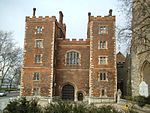Lambeth Walk
History of the London Borough of LambethRetail markets in LondonStreets in the London Borough of LambethUse British English from June 2015Working class in England

Lambeth Walk is a street in Lambeth, London, England, off Lambeth Road. It was at the heart of a working-class residential area and there was a street market. The area was originally developed with wells and a recreation ground. Houses followed in the 19th century. After some bomb damage during the Blitz in World War II on 18 September 1940, the area became rather run-down and was subsequently rebuilt. Some older buildings survive, including the Henry Moore Sculpture Studios, image adjacent.
Excerpt from the Wikipedia article Lambeth Walk (License: CC BY-SA 3.0, Authors, Images).Lambeth Walk
Fitzalan Street, London Kennington (London Borough of Lambeth)
Geographical coordinates (GPS) Address Nearby Places Show on map
Geographical coordinates (GPS)
| Latitude | Longitude |
|---|---|
| N 51.49387 ° | E -0.11436 ° |
Address
Fitzalan Street 51-54
SE11 6QX London, Kennington (London Borough of Lambeth)
England, United Kingdom
Open on Google Maps








